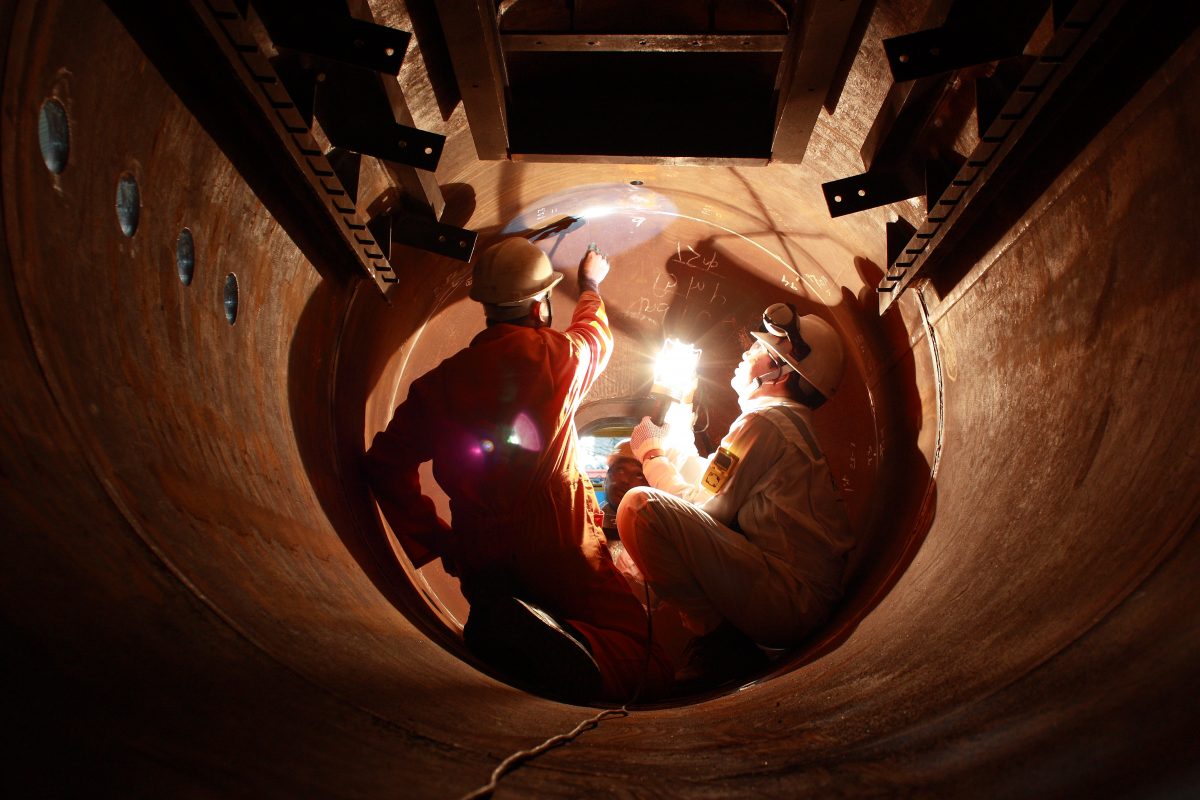Interview: Safetytech Leader Interview with Dr Richard Judge
16/08/2021
Last year, Lloyd’s Register Foundation published the Foresight Review of ‘The Future of Regulatory Systems’, in partnership with The Economist. Maurizio Pilu, MD of the Safetytech Accelerator spoke to the author of the report, Dr Richard Judge (formerly Chief Executive of the Health and Safety Executive), on the seismic shifts taking place in regulatory systems and the influence of tech on these changes.
“Richard, thanks for talking to us. Firstly, congratulations on the launch of the report, I think our readers will be fascinated to hear first-hand from you about the ins and outs of it. At the launch of the report, there were several key points debated, what were those and what has the reaction been since?
Thanks Maurizio, I’m pleased that you found our report of interest. We were grateful to the many people who contributed their insights and experience, including yourself, of course.
The Economist event (“make or break: regulating in a disruptive-world”) attracted some 200 senior executives from 40 countries and was well received. We discussed questions ranging from future roles for technology and data, through to how we might encourage even greater collaboration across traditional boundaries and “who regulates the regulators?”
We’re continuing to raise awareness of the issues and opportunities identified in our report, including at the forthcoming World Congress on Occupational Safety and Health.
An excellent turnout for the event. A turnout that may surprise some, with the topic of regulation perhaps not being seen to be very exciting. What’s your perspective on regulation, why should we all be looking at it differently?
As ever, it all depends how you look at it. If you see regulation as just a list of rules to comply with, then it might seem dull.
However, one can also see regulation as the framework that shapes the way that people and organisations behave. Viewed in this light, it is highly relevant and very important. Regulation is about human psychology and knowledge, about power and political dynamics, and ultimately about protecting lives, livelihoods and the critical physical, natural and social infrastructures that we all rely on. What’s not exciting about that?
When you look at it from a human perspective, it does make things much more interesting. You have chosen the term regulatory systems, instead of regulation. Can you tell us more about why you made that choice and if and how it helped unpack what the future of regulations could look like?
Yes. We were keen to recognise the many people and organisations whose influence can, together with the “rules”, encourage the right behaviours and make a positive (or negative) difference. Thinking in this whole of system way opens up even more regulatory options. You’ve got hard powers to license and enforce; softer powers to shape behaviour through policies and influence; and scientific data and insight to underpin it all.
New Zealand’s “regulatory stewardship” model is an interesting example of this model in action. But they aren’t the only country looking for novel solutions – we’re seeing regulatory developments and innovations in many diverse areas.
However, the most important point to remember is that there aren’t (and can’t be) any simple answers. Context is everything: what works in one place or for one type of issue may not work elsewhere. There is, for example, a huge difference between a sector dominated by a small number of very powerful international businesses and one with many thousands of micro businesses that come and go. The art of regulation lies in making skillful use of available and appropriate tools, often in combination: so in choosing which tools to use when.
The world is changing dramatically, with many disruptions to the status quo. We therefore make the broader point that systems thinking is essential if we are to cope with the systemic challenges of such disruptive environments. Understanding the regulatory system, and the dynamics of the issue being regulated, becomes ever more important: you have to be able to differentiate between the many straightforward issues, where established methods work well, and disruptive issues requiring radically different responses. As you can imagine, that’s much easier said than done.
I think from hearing that, we can all agree that the art of regulation is not an easy one. Now, let’s now dive into tech – our forte at Safetytech Accelerator. As you know our role is to help drive the adoption of Safetytech. Are there opportunities for change and improvement that could enable a new wave of safety and risk tech innovation within industrial sectors? Could these help solve some of those systemic challenges?
There’s no shortage of applications for technology, with some of the immediate opportunities linked to making the most of data we already have. You’re already seeing those in areas such as asset management – where data from sensors can be used to improve maintenance practices. Even bigger shifts can be seen in areas such as electricity generation – where technology could allow a much more dynamic, distributed and smaller scale infrastructure to provide reliable generation capacity or could shape demand for power.
While there is plenty of opportunity, there are also many big questions to resolve that go well beyond technology. When exploring tech innovation, the interactions between technology, people and society are fundamental. We may find ourselves overestimating technology’s capabilities, so being clear on the limitations as well as the possible is going to be really important.
If we look at industrial sectors, safety tech and regtech clearly overlap – could you comment on where you see the difference?
Both Safetytech and regtech share the end goal of using technology to help protect people and society from harm, so the overlap isn’t surprising. The difference is probably down to intended application – with regtech supporting regulatory oversight or demonstration of compliance.
But the distinction does raise interesting questions, with implications for organisational behaviours: who pays for developments and who carries the risks? There are also new dilemmas: if regtech gives the regulator ever more access to live data, then at what point does the regulator become culpable for not stopping an accident that could be predicted from this data?
Here are two examples of regtech solutions in the safety and risk management space:
-
Using health and safety data to help prevent future incidents in the construction sector
-
Transforming food safety, assurance and compliance using AI technology
It sounds like regtech will push some real changes in regulatory systems, what other challenges do you see regtech facing in the future?
RegTech definitely has a valuable part to play in future regulatory systems – but context will be everything and so exactly how technology gets used will vary.
There’s already lots of activity in this space – pilot applications tend to focus on very practical improvements that build what is already being done: such as how to track food origins or how to identify those businesses that present a greater risk of harm. We’re seeing that these initiatives can find it difficult to scale up from a pilot to widespread application. In part, this is down to questions about data ownership and privacy. The lesson is probably to put at least as much attention on building trust with people (which then allows their data to be shared and used productively) as you do on the technology.
Such a great point, Richard, it’s not just about the tech. In that respect, I wanted to touch on regulatory sandpits that you covered nicely in your report, and to some extent we do in the Accelerator. Can you tell us more about why you think they are important and how they work – and where should we do more?
Understandably, businesses like certainty – and so being clear on how regulators are thinking, where regulators see the biggest risks or views on the acceptability of concepts can all help with innovation, sandpits help here, to test things out. However, there has to be a degree of realism: certainty may not be possible where there is inherent uncertainty whether this is down to technological complexity or divergent societal views.
Safetytech Accelerator is collaborating with Lloyd’s Register to find out how drones and robots can be used to minimise inspection-relate confined space entries, especially when these inspections are bound to regulatory codes and standard requirements.
Yes, we’ve had enough uncertainty in the last 18 months! So, my last question to you. Is there an area or two in the report you wish you could have explored in more detail?
One of the goals of our review was to highlight “big” questions that were worth exploring in more detail. I’ll choose one example relevant to your Safetytech work and to the adoption of innovative technologies. This is about the challenges of blending the old and the new. How do you implement very new concepts and technologies of the information age onto critical infrastructures where there is a high reliance on knowledge bases, processes and mind-sets designed for the industrial age?
There’s plenty to explore in that space: transitions are often complex, contradictory and chaotic! I’m considering some of the issues in on-going research into the governance of complex systems. A specific question is around how to let go of old, previously successful practices that are no longer relevant, and potentially dangerous, in disruptive environments. That relies on trust which, together with being able to benefit from cognitive diversity and effective communication of uncertainties, will be so important to us in increasingly disruptive worlds
Richard, many thanks for taking the time to speak with me and sharing your thoughts, we look forward to a great future of regtech and Safetytech helping to make the world a safer place.”
If you are interested to find out more about the Safetytech Accelerator please get in touch with us here, otherwise stay tuned for further interviews with innovation leaders.

